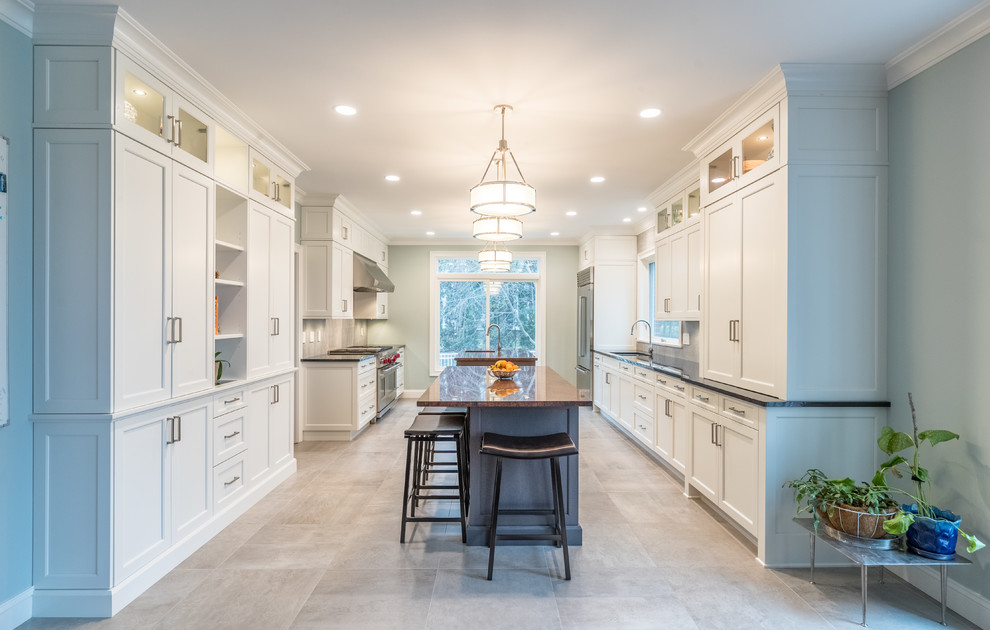Open Concept Homes: Where Form Meets Function and Life Flows Freely

The allure of open concept living is undeniable. It’s a style that speaks to our desire for spaciousness, connection, and a seamless flow of life. Gone are the days of cramped, compartmentalized homes. Today, we crave a sense of openness, a space that reflects the fluidity of modern living.
But what exactly defines an open concept home? And how can it be tailored to your specific needs and lifestyle? This is where the expertise of a skilled architect and interior designer comes in. We’ll delve into the nuances of open concept design, exploring its key features, benefits, and how it can be seamlessly integrated into your dream home.

Here’s what we’ll cover:
- Defining Open Concept: Understanding the essence of open concept design and its evolution.
- Key Features: Exploring the defining elements that make open concept homes unique.
- Benefits: Unveiling the numerous advantages of embracing an open floor plan.
- Customization: Tailoring open concept design to suit your individual needs and lifestyle.
- Challenges: Addressing potential drawbacks and finding solutions to ensure a functional and comfortable space.
- FAQs: Answering common questions about open concept living.
- Conclusion: A call to action, encouraging you to embrace the possibilities of open concept design.




Let’s begin by understanding the essence of open concept design.
Defining Open Concept: A Modern Approach to Living

Open concept design is not simply about knocking down walls. It’s a deliberate approach to creating a cohesive and functional space that prioritizes flow, connectivity, and a sense of openness. The core principle lies in eliminating physical barriers between distinct areas, allowing for a seamless transition between living, dining, and kitchen spaces.

This approach has its roots in the mid-20th century, fueled by the rise of modernism and a desire for a more relaxed and informal lifestyle. Open concept homes emerged as a reaction to the traditional, compartmentalized layouts of the past.
But the concept has evolved significantly since its inception. Today, open concept design is not merely about maximizing space; it’s about creating a dynamic and inviting environment that reflects the way we live. It’s about fostering a sense of connection, both within the home and with the outside world.

Key Features of Open Concept Homes: Unveiling the Essence
Open concept homes are characterized by several defining features that contribute to their unique aesthetic and functionality. Let’s explore these key elements:
- Open Floor Plan: The defining characteristic of open concept design is the absence of walls separating the living, dining, and kitchen areas. This creates a continuous flow of space, enhancing the sense of openness and connectivity.
- Large Windows and Natural Light: Open concept homes often feature expansive windows that flood the interior with natural light. This not only brightens the space but also blurs the lines between indoors and outdoors, fostering a sense of connection with the environment.
- Multifunctional Spaces: Open concept layouts encourage the use of multifunctional furniture and design elements. A sofa can double as a guest bed, a coffee table can be used for dining, and a kitchen island can serve as a breakfast bar. This versatility allows for flexibility and adaptability.
- Minimalist Design: Open concept homes often embrace minimalist design principles, prioritizing clean lines, simple forms, and a neutral color palette. This approach helps to maintain a sense of order and spaciousness, allowing the architecture and natural light to take center stage.
- Integration of Indoor and Outdoor Spaces: Open concept design often extends beyond the interior walls, seamlessly connecting the living space with outdoor areas like patios, decks, or balconies. This creates a sense of continuity and allows for a more fluid flow of life between indoors and outdoors.


:format(jpeg)/cloudfront-us-east-1.images.arcpublishing.com/tgam/5ZXL4FGMHJGTFMDW4NP2KNBKQI.jpg)
Benefits of Open Concept Living: A Symphony of Space and Connection
The allure of open concept homes lies in the numerous benefits they offer, enhancing both functionality and lifestyle. Let’s delve into the advantages of embracing an open floor plan:

1. Enhanced Space and Light:
- Open concept design eliminates the visual barriers created by walls, making the space feel larger and more expansive.
- The absence of walls allows for a greater flow of natural light, brightening the entire home and creating a more welcoming atmosphere.
- This increased sense of space and light can positively impact mood and well-being.
2. Improved Flow and Connectivity:
- The open floor plan facilitates a seamless transition between different areas of the home, making it easier to move around and interact with others.
- It fosters a sense of connection between family members and guests, encouraging communication and shared experiences.
- This improved flow can be particularly beneficial for families with young children or for entertaining guests.
3. Flexibility and Adaptability:
- Open concept layouts offer greater flexibility, allowing for different configurations and uses of the space.
- Multifunctional furniture and design elements can be easily rearranged to suit changing needs and preferences.
- This adaptability makes open concept homes ideal for evolving lifestyles and families.
4. Visual Appeal and Modern Aesthetic:
- Open concept design often incorporates modern architectural elements and minimalist design principles, creating a sleek and sophisticated aesthetic.
- The clean lines, open spaces, and natural light contribute to a sense of order and tranquility.
- This contemporary design approach can enhance the overall visual appeal of the home.
5. Enhanced Value and Resale Potential:
- Open concept homes are highly sought-after in today’s real estate market, making them a valuable investment.
- The spaciousness, functionality, and modern aesthetic appeal to a wide range of buyers, increasing resale potential.
- This can be particularly advantageous for those considering selling their home in the future.
Customization: Tailoring Open Concept Design to Your Needs
While open concept design offers numerous benefits, it’s essential to remember that it’s not a one-size-fits-all solution. The ideal open concept layout will be tailored to your specific needs, lifestyle, and preferences.
Here are some key considerations for customizing your open concept home:
- Family Size and Lifestyle: Consider the number of people living in the home and their individual needs. A large family might require more defined spaces for privacy and individual activities.
- Entertaining Preferences: If you frequently entertain guests, consider incorporating features that enhance social interaction, such as a large kitchen island, a spacious dining area, or a dedicated bar space.
- Privacy Concerns: While open concept design prioritizes openness, it’s important to consider privacy needs. You can create semi-private spaces within the open floor plan using furniture arrangements, room dividers, or strategically placed walls.
- Personal Style and Aesthetics: Open concept design can be adapted to suit any personal style, from minimalist and contemporary to traditional and eclectic. Choose finishes, colors, and furniture that reflect your taste and create a cohesive and inviting atmosphere.
- Budget and Constraints: Open concept design can be achieved within various budgets. Work with your architect and interior designer to create a plan that aligns with your financial constraints and prioritize the features that are most important to you.
Addressing Challenges: Ensuring Functionality and Comfort
While open concept homes offer numerous advantages, it’s important to acknowledge potential challenges and address them proactively. Here are some common concerns and practical solutions:
- Noise Control: Open concept layouts can amplify noise, making it difficult to have private conversations or create quiet spaces for work or relaxation. Solutions: Consider using sound-absorbing materials, strategically placing furniture, and incorporating acoustic panels to reduce noise levels.
- Privacy Concerns: The absence of walls can create a lack of privacy, especially in areas like bedrooms or home offices. Solutions: Utilize room dividers, furniture arrangements, or strategically placed curtains to create semi-private spaces.
- Heating and Cooling: Open concept homes can be challenging to heat and cool efficiently, as the entire space is open to the elements. Solutions: Consider using zoned heating and cooling systems, installing high-efficiency appliances, and incorporating energy-saving features like insulation and smart thermostats.
- Clutter Management: Open concept layouts can make clutter more visible, requiring careful attention to organization and storage solutions. Solutions: Embrace minimalist design principles, utilize built-in storage solutions, and implement a decluttering strategy to maintain a clean and organized space.
- Limited Flexibility: While open concept design offers flexibility, it can also limit the ability to create distinct spaces for specific activities. Solutions: Consider incorporating movable furniture, room dividers, or flexible design elements that allow for adaptability and customization.
FAQs: Unraveling the Mysteries of Open Concept Living
Here are some frequently asked questions about open concept homes, along with insightful answers:
1. Is open concept design suitable for all homes?
Open concept design can be adapted to various home styles and sizes. However, it’s essential to consider the existing structure, the size of the space, and the desired functionality. A skilled architect and interior designer can help determine if open concept design is feasible and how to best implement it.
2. How can I create privacy in an open concept home?
There are several ways to create privacy within an open concept layout:
- Furniture Arrangements: Strategically placed furniture can create natural divisions within the space, defining different areas and providing visual barriers.
- Room Dividers: Freestanding screens, curtains, or bookshelves can be used to create semi-private spaces without completely closing off the area.
- Strategic Walls: Incorporating strategically placed walls can define specific areas while maintaining the overall open feel.
- Lighting: Using different lighting levels can create distinct zones and enhance privacy within the open space.
3. What are the best materials for an open concept home?
Open concept homes often feature materials that enhance the sense of spaciousness and light:
- Light-Colored Walls: Neutral or light-colored walls reflect light, making the space feel larger and brighter.
- Large Windows: Expansive windows allow for maximum natural light and blur the lines between indoors and outdoors.
- Natural Materials: Incorporating natural materials like wood, stone, or bamboo adds warmth and texture to the space while maintaining a clean and modern aesthetic.
- Reflective Surfaces: Mirrors and glossy finishes can reflect light and create a sense of depth and openness.
4. How do I decorate an open concept home?
Decorating an open concept home requires a thoughtful approach to maintain a cohesive and balanced aesthetic:
- Color Palette: Choose a neutral color palette as a foundation and incorporate pops of color through accents, furniture, or artwork.
- Furniture: Opt for multifunctional furniture that serves multiple purposes and can be easily rearranged to suit different needs.
- Lighting: Use a combination of ambient, task, and accent lighting to create different moods and highlight specific areas.
- Accessories: Add personality and warmth with carefully selected accessories, artwork, and plants.
5. How much does it cost to create an open concept home?
The cost of creating an open concept home varies depending on the size of the space, the extent of renovations, and the materials used. It’s essential to consult with an architect and interior designer to get a realistic estimate of the costs involved.
Conclusion: Embracing the Possibilities of Open Concept Design
Open concept homes offer a unique and rewarding approach to living, fostering a sense of connection, spaciousness, and fluidity. By embracing the key features, benefits, and customization options, you can create a truly personalized and functional space that reflects your lifestyle and aspirations.
Don’t be afraid to push boundaries and explore the possibilities of open concept design. With the guidance of skilled professionals, you can transform your home into a haven of light, flow, and connection.
Ready to embark on your open concept journey? Contact us today to discuss your vision and explore the possibilities of creating a home that truly reflects your unique lifestyle.
/cloudfront-us-east-1.images.arcpublishing.com/tgam/73PNDUAX4VG4ZNIX4ZHEOJQY7U.jpg)
